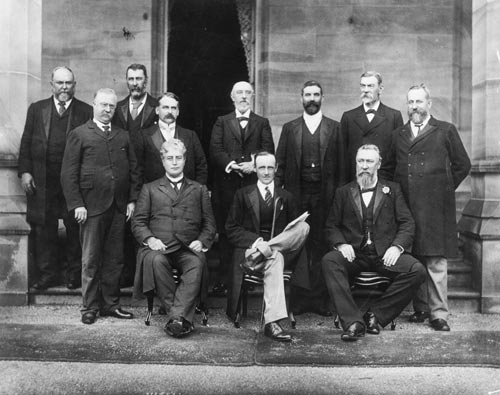Declaration of the Commonwealth
We do hereby declare that on and after the first Day of January one thousand nine hundred and one, the people of New South Wales, Victoria, South Australia, Queensland, Tasmania and Western Australia shall be united in a Federal Commonwealth under the name of the Commonwealth of Australia.
Queen Victoria, Proclamation, 17 September 1900.
The Commonwealth of Australia was established on 1 January 1901, and the Australian Constitution came into effect on that date. A ceremony in Centennial Park, Sydney, formally marked the beginning of the new nation and established elements of the first Commonwealth government. The Governor-General, Lord Hopetoun, swore to faithfully serve the Queen and the Commonwealth, and proclaimed that he had taken office. He then, in the Queen's name, appointed the ministers of the first government and swore them in as members of the Executive Council.
|
|
Ceremony for the declaration of
the Commonwealth, Centennial Park,
Sydney, 1 January 1901
National Library of Australia |
|
|
Panoramic view of Centennial Park, Sydney.
Celebration for the inauguration of the Australian
Commonwealth, 1 January 1901
National Library of Australia |
A Cabinet of Kings


| The leader of the government, Edmund Barton, was called Prime Minister by convention only. He gathered around him a ‘cabinet of kings’ which included six former or serving state premiers.
In selecting at least one representative from each state, Prime Minister Barton commenced a tradition which continues to this day. Seven departments of state were created at the first meeting of the Executive Council on 1 January 1901. |
The Barton ministry of 1 January 1901
Image Library, State Library of New South Wales
Front, from left: Edmund Barton (NSW), Minister for External Affairs; Lord Hopetoun, Governor-General; Sir William Lyne (NSW), Minister for Home Affairs. Middle row: Sir George Turner (Vic.), Treasurer; Sir Neil Lewis (Tas.), Minister without portfolio; Sir James Dickson (Qld), Minister for Defence; Alfred Deakin (Vic.), Attorney-General; A.C. Budge, Clerk of the Executive Council; Charles Kingston (SA), Minister for Trade and Customs. Back row: Sir John Forrest (WA), Postmaster-General; Richard O’Connor (NSW), Minister without portfolio |
|


